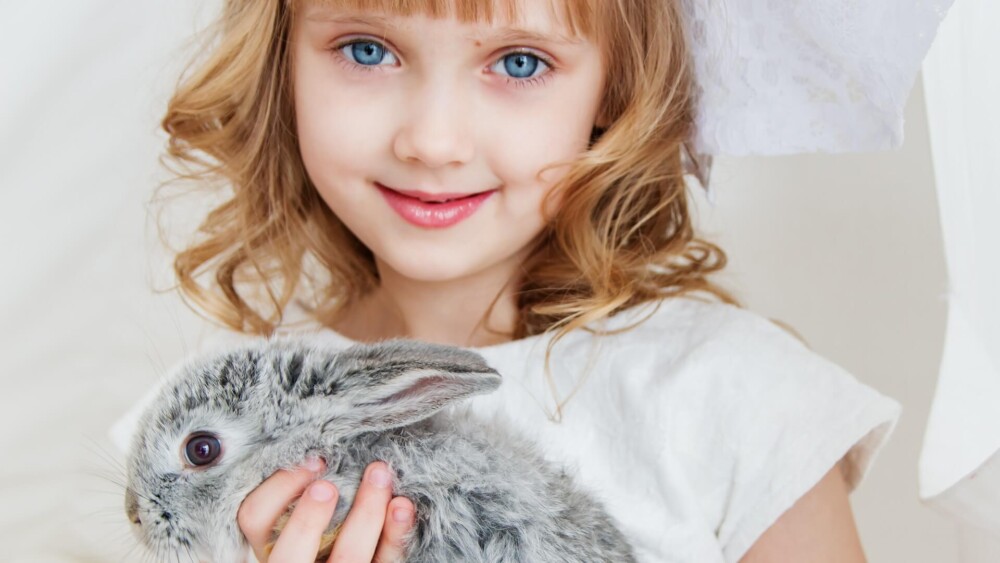Rabbits are such cute, fluffy, sociable mammals that you might think they love to cuddle. But, while rabbits like attention, they don’t generally like being held.
Table of Contents
- Reasons You Need to Hold Your Rabbit
- Differences Between Holding Large Rabbits and Smaller Rabbits
- When To Pick Up and Hold a Baby Rabbit
- How to Hold a Rabbit Correctly: Step by Step Guide
- Pro Tips for Holding a Difficult Rabbit
- Consequences Of Poor Handling Of A Rabbit
- The Worst Ways to Hold a Rabbit
- Holding a Rabbit Properly FAQ
- Conclusion
A few years ago, a neighbor kid found a rabbit that escaped its hutch. The little boy had three cats at home held the rabbit-like it was a cat – by the scruff of its neck.
I realized that Sam didn’t know how to correctly hold a rabbit. Holding rabbits requires knowledge and skills.
How do you hold a rabbit? The best way to hold a rabbit is to always fully support the rabbit’s body weight. Place one hand or arm underneath the rabbit and your other hand underneath the forelegs. Support the top part of its body to give you a more secure hold.
You can hold the rabbit in the heart-to-heart position or in the rabbit-back-to-your-front position, cradle the rabbit, let it lay on your forearm while you securely hold its back, or swaddle it.
Never hold a rabbit by its ears, scruff, one leg or two, or in the trance position, as these can lead to injury (to you and/or the rabbit) or death.
Thus, correctly holding a rabbit (and even approaching it correctly) is very important to ensure that your rabbit doesn’t get injured or that it doesn’t hurt you. In general, most rabbits don’t like to be held and cuddled, and it is very rare if a rabbit does enjoy this. Responsible rabbit owners respect their rabbit’s autonomy and only hold them when it is necessary.
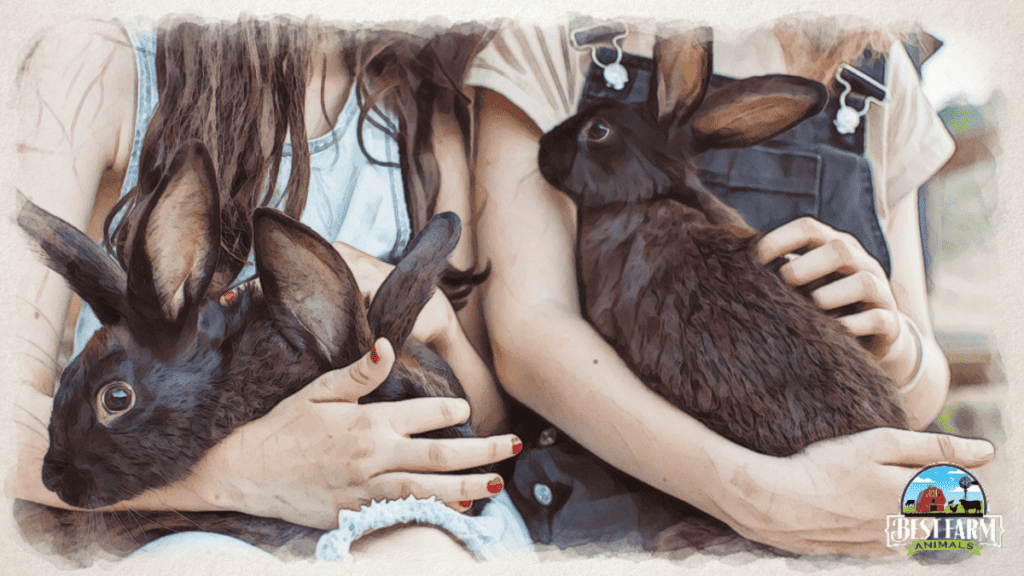
Reasons You Need to Hold Your Rabbit
Before I look at the best and worst ways to hold a rabbit, you may be curious to know about the reasons you need to pick up and hold your rabbit. It won’t be for cuddles. While you might enjoy cuddling with your rabbit, they won’t.
You shouldn’t pick up and hold a rabbit unless there is a reason. Rabbits are prey animals. When there is a predator close by, the rabbit’s body releases stress chemicals. Your rabbit might think you are a predator if they don’t know you and aren’t familiar with you. This causes the rabbit to heighten its senses in a flight-or-fight response.
Being held makes them feel as if they are trapped and in danger. Rabbits scare easily and in extreme cases, it can cause cardiac arrest.
Most common reasons to hold a rabbit:
- Move them to safety and out of harm’s way
- Weigh a rabbit
- Place a rabbit in a carrier when I travel for rabbit shows or take them to the vet.
- Take them out and place them back inside their hutch or cage
- Identify a rabbit’s sex
- Clip their nails
- Brush them during shedding or molting season to help remove extra fur
- Give medicine when a rabbit is sick
How often should you pick up your rabbit?
You can pick your rabbit up to three times a day but don’t cuddle them for more than 10 minutes. Unlike other pets like cats, which love to held too often, bunnies are prey animals and easily become scared. Coughing alone can spook a rabbit and make it run into hiding. I’ve rabbits that approach me whenever they spot me, but still, I avoid picking them up too often.
Note that picking rabbits is totally different from supervising them. You need to spend several hours with bunny every day. That helps boost their friendship with people. These pet animals also need to be supervised outside of their cages to ensure that they play and get enough exercise to stay healthy and happy.
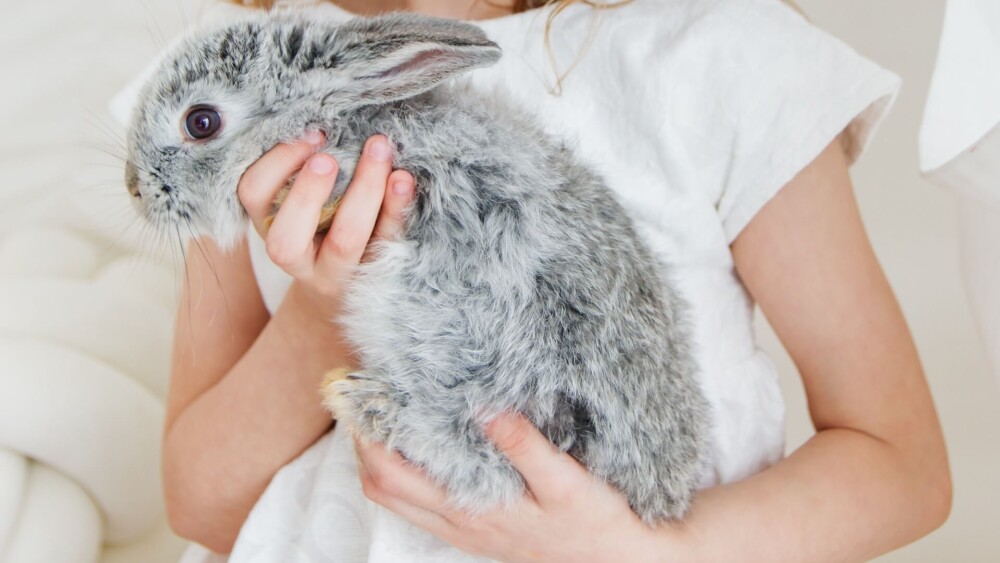
Differences Between Holding Large Rabbits and Smaller Rabbits
I have two large rabbit breeds (English Lop and New Zealand rabbit) and some smaller breeds (Mini Rex, Holland Hop, Havana, and a Harlequin) on my homestead. I’ve learned that there is a difference when holding a large breed versus a small breed.
With larger breeds, approach them confidently from the front so the rabbit can see you coming. Stand behind the rabbit. Firmly place one hand under the bottom and one hand on the chest below the front legs. At this point, you can lift. Pick up the rabbit with its back to your chest.
With a smaller breed, including mini or dwarf rabbits, pick the rabbit up from the front. Place one hand underneath its bottom and the other under the two forelegs. Lift the bunny and bring it closer to you. Hold it in the heart-to-heart position. The hindlegs will be curled and resting on your rib cage while the forelegs rest on your upper chest. Essentially, it’s a bunny hug.

When To Pick Up and Hold a Baby Rabbit
Avoid holding your newborn rabbits until they’re about two weeks old. That’s because baby bunnies are fragile, have weak bones, extremely soft skin, and may not cope with excessive human contact. After two weeks, you can hold the baby rabbits for a few minutes daily.
However, I wait for only 10 days before I can start petting and holding my baby rabbits. They usually flinch at first but with time, say three days to one week later, they’ll readily jump toward me and hop into my hands. Frequent interaction for a few minutes every other day helps them socially as they learn to interact with people.
When my first doe had a litter one year, I wasn’t sure if I could hold the babies, so I spoke with my vet.
Can you hold a baby rabbit? You can hold baby rabbits but should avoid it until they are 3 weeks old. If possible, check on them without picking them up. Newborn rabbits, called kittens, are born blind and deaf. They are easily injured from being held. Their ears are closed, and they are hairless. Baby rabbits can’t regulate their body heat yet, so they burrow in the nest with their mom.
If it has wriggled out of the nest, I only pick up a baby rabbit and need to be placed back with the litter.
I also pick up the kittens to weigh them. I keep a little notebook so I can make sure they are being fed and are drinking enough.
But kittens are very fragile and they are tiny, so I make sure to handle them with care, supporting their back and placing a hand underneath them. When the kittens are three weeks and older, I interact more with them and pick them up as I would a small rabbit breed.

How to Hold a Rabbit Correctly: Step by Step Guide
Old a rabbit correctly and avoid injury take these steps:
Step 1: Pick up the Rabbit Properly
Before you can correctly hold a rabbit, you need to pick it up properly. This means ensuring the whole of the rabbit’s body is supported and using two hands.
Place your one hand under the two front paws, which helps prevent the rabbit from struggling and wriggling away, and with your other hand, place it under the rabbit’s bottom to support their body.
Lift the rabbit with its back to your front if it is a large breed or chest-to-chest for a small breed. This close body contact helps the rabbit feel more secure, and you can place your arms around the rabbit for a stronger hold.
Step 2: Hold the Rabbit Securely
There are several ways to securely hold a rabbit.
Heart-to-Heart Position: The heart-to-heart position is ideal for small rabbit breeds. In the heart to heart position, the rabbit places their front paws on your shoulder or upper chest. With one hand or arm, support the rabbit’s bottom. This helps keep them stable.
Back to Front: Back to front works well for large and small rabbit breeds. Keep their backs to your front. Support their front and hind legs with your hands or arms. You can also use this position when you need to clip your rabbit’s nails, even if it is a small breed.
Cradle Position: To initiate the cradle position, start with the heart-to-heart position. Keep ahold of the bottom and let the rabbit “rest” their body on your upper arm, thus cradling them. Ensure you keep their head up while they almost sit on your arm.
Lower Cradle Position: Your rabbit can lay on your lower arm while holding them by their back. This provides support to the rabbit and it helps you keep the rabbit in your arms.
Bunny Burrito: In the bunny burrito method, you swaddle a rabbit in a towel. This is an effective way to hold a rabbit especially when you need to administer medicine.
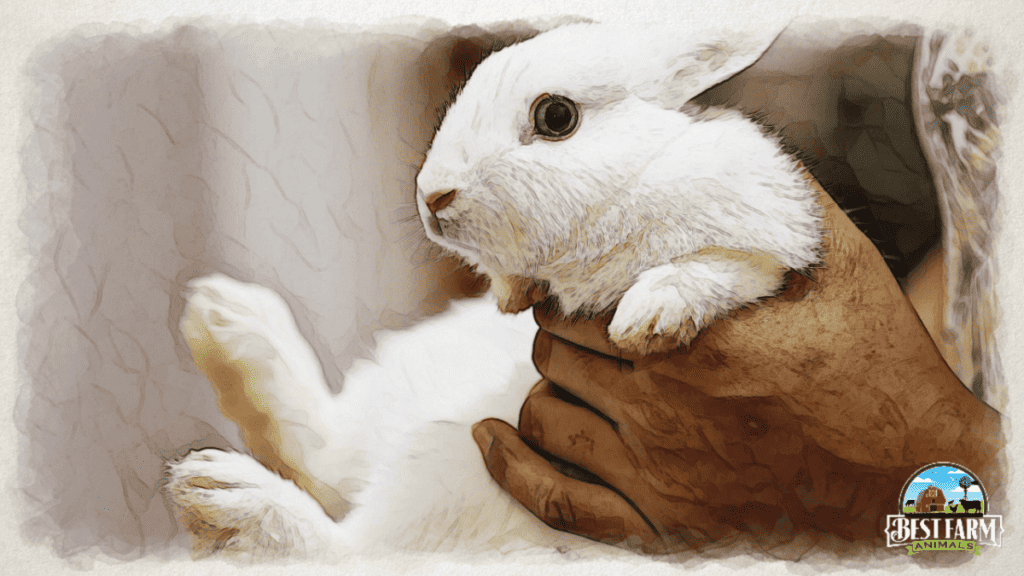
Do rabbits like being wrapped in a towel?
Rabbits love being wrapped in towels and other soft fabrics. They love the warmth and softness that come with towels. When I wrap a towel around my pet rabbit, he always appears peaceful and relaxed. It’s almost as if he knows it’s time for his spa day!
He snuggles into the towel while I wrap him up and sometimes falls asleep. I suppose every rabbit is different, but the towel appears to be a source of comfort and warmth for my fuzzy pet.
Step 3: Put Your Rabbit Down Safely
You’ll need to put the rabbit back on the ground at some stage. You want to make sure you have a firm hold of the rabbit. When you are ready, kneel or squat down to get closer to the ground. Then slowly loosen your hold on the rabbit, and let it hop away.
I usually treat my rabbit once I’ve put it down as a reward for “good behavior.”
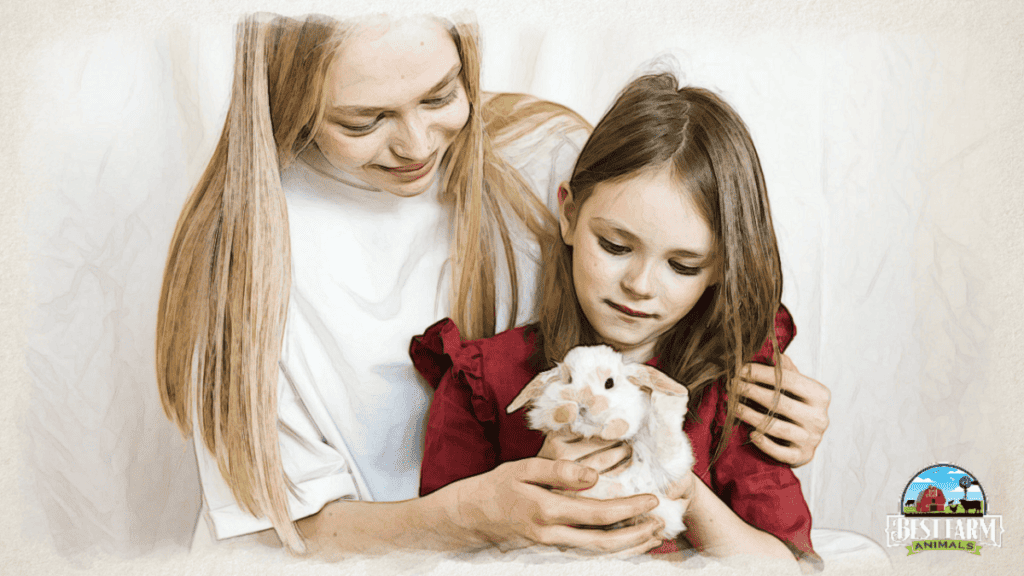
Pro Tips for Holding a Difficult Rabbit
Most rabbits don’t like to be picked up, but there are a few tips you can use when dealing with such a rabbit.
How to Pick Up A Rabbit That Hates It
- Ensure the rabbit is calm before you pick it up. I generally pet and play with my one feisty rabbit before holding it.
- I get down on the ground and try to make myself as level as possible with my rabbit when I want to pick it up. This is kind to my back and helps me have a better grip as I pick up my rabbit. It also has the added benefit of making me smaller so my rabbit doesn’t see me as a threat.
- I spend time training a tricky rabbit by putting it in areas where I’m likely to touch it while picking it up and holding it.
- I only pick up and hold a difficult rabbit when I need to.
Consequences Of Poor Handling Of A Rabbit
It’s critical that you learn how to correctly hold your rabbit. One study found that 60% of rabbits struggle when you pick them up (see references), and showing fear-related aggressive behavior is common.
Your rabbit will get very stressed when it feels scared because they are fragile. They have a high body muscle-to-bone ratio, with their skeleton comprising 7-8% of their body weight, while the skeletal muscle makes up 50% or more of their body weight. A rabbit’s spine is their weak point, and their hind limb muscles are powerful, creating risk when held.
A rabbit that’s insecure will usually kick. But, the kick can cause damage to their spinal cord and fracture a vertebra. This can result in paralysis.
Rabbits that are especially scared or have had bad experiences will try to escape your grasp. This can cause injury, including internal organ damage, broken bones, or spinal injuries.
In addition, a strong, swift kick can injure you. Your rabbit may scratch or bite you. Rabbits don’t normally bite unless they are terrified.
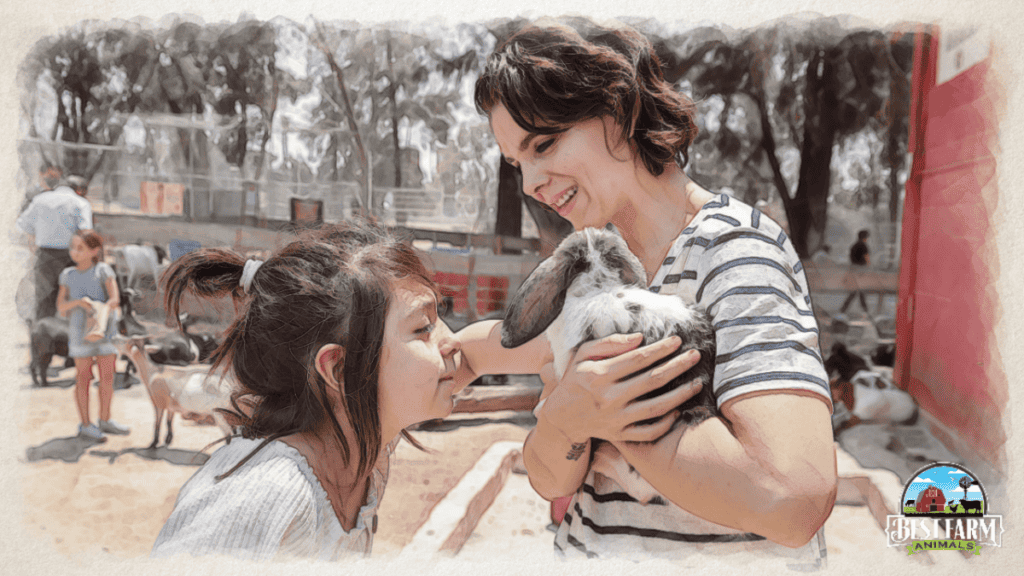
What Is The Safest Way To Pick Up A Rabbit?
To hold and pick your rabbit safely, use your one hand to support the lower half of the body and tuck your other hand under the bunny’s chest. I usually pet my rabbits to relax and comfort them while picking them up. This ensures that they feel safe; even if you mistakenly pick them wrongly, they won’t be quick to bite or wiggle themselves out!
Make sure that you provide upper and lower body support when holding the rabbit. When you pick up the rabbit, ensure she sits firmly on your chest. You want to look at their feet to see if they are dangling because a tense rabbit won’t move its feet. When putting the bunny down, make their feet touch the ground first.
Sometimes, I just scoop up my rabbits with both hand and hold them firmly against my stomach. However, to execute this method, you have to ensure that you one of your hands holds the bunny’s behind and the other hand holds the other half part of the body.
The Worst Ways to Hold a Rabbit
During the lesson on how to hold a rabbit, I first started by showing the little boy how not to hold his bunny. Let’s cover where not to hold a rabbit:
Never Hold a Rabbit By the Ears
Never ever pick up your rabbit by its ears. If you do, the hindlegs are not supported. Because they are heavier in comparison to the rest of its body, the legs put a strain on the spine as they hang.
Second, your bunny’s ears aren’t strong enough to support the weight of its entire body. Holding it by the ears can cause tissue damage and injury. It is also painful.
Never Hold Rabbits By the Scruff
Never hold a rabbit by its scruff like you do a cat. The skin behind a rabbit’s neck is too fragile and it can’t completely support the rabbit’s weight.
This results in pain for your rabbit as it places too much strain on the muscles here, and the muscles could even tear. The rabbit could also act out and injure you.
Avoid Holding Rabbits By the Legs
Never pick up a rabbit by grabbing hold of one or two of its legs. Your rabbit may break a leg in an attempt to getaway. In a best-case scenario, it’s probably going to pull a muscle or sprain its leg. Both of which are still terribly painful.
Holding Rabbits In the Trance Position
There is much controversy around the topic of trancing a rabbit these days. When you trance a rabbit, you turn it onto its back so its feet are up in the air. Some pet owners place their rabbits in this position to clip their nails or for grooming purposes.
However, studies have found that the rabbit’s heart rate will rise and its body will release a lot of stress hormones. As such, I only put a rabbit in the trance position as a last resort, but I dislike placing my rabbits in any form of discomfort.

Holding a Rabbit Properly FAQ
Lets recap with some of the most common questions people ask about holding rabbits.
How do I make a rabbit comfortable with being held?
To make a rabbit comfortable with being held, it’s important to familiarize yourself with the rabbit first and let them get used to your presence. Sit beside their cage or hutch at their eye level to appear less intimidating. Offer treats like lettuce or carrot to establish trust. Start by petting the rabbit gently and avoid touching its head initially. Gradually build up to holding them using proper techniques.
Can I hold a rabbit by its ears or scruff of the neck?
You should never hold a rabbit by its ears or scruff of the neck. These areas are sensitive and holding them this way can cause pain and potential injury to the rabbit. Instead, always support the rabbit’s chest and bottom when picking them up to ensure they are fully supported.
Do rabbits enjoy being held?
Rabbits are prey animals and have a natural instinct to prefer having their feet on the ground. While there are exceptions, such as some calm-natured or well-socialized rabbits, rabbits may feel trapped and anxious when being held. It’s important to respect your rabbit’s comfort and avoid excessive handling unless necessary.
How should I hold a rabbit to ensure their safety?
When holding a rabbit, it’s crucial to support their entire body. Use one hand to cradle their chest and the other hand to support their bottom. This ensures their weight is evenly distributed and prevents them from squirming or falling.
How can I gain a shy rabbit’s trust to be held?
For shy rabbits, giving them space and time to become comfortable around you is important. Avoid picking them up until they are very comfortable in your presence. Gradually build trust through positive interactions, offering treats, and allowing the rabbit to approach you willingly. Once the rabbit is at ease, you can begin practicing gentle handling techniques.
Conclusion
Holding a rabbit correctly is important to building trust and keeping your bunny safe. Although rabbits are resilient, they can injure easily and incorrect holding is a cause of many rabbit injuries.
If you found this article helpful, please consider sharing it with other rabbit owners and enthusiasts. After all, a more informed rabbit community is a stronger one, and our furry friends will thank us for it.
I’d also love to hear your experiences and tips about rabbit handling.
Lastly, subscribe to our blog for more insightful articles about rabbit care, filled with practical advice and expert guidance. Let’s continue learning together, always striving to be the best rabbit owners we can be.
Recommended Rabbit Supplies
This list contains affiliate products. Affiliate products do not cost more but helps to support BestFarmAnimals and our goal to provide farm animal owners with accurate and helpful information.
Housing: If your rabbit is indoor, you’ll need a cage, a hideout (to keep your rabbit from death by heart attack), and a space for it to get exercise and spend time with you. If you don’t want to let it run free in your house, this animal playpen provides space and keeps your rabbit from hiding under your couch.
If you keep your rabbit outdoors, an outdoor hutch that provides space and protection from predators is needed. (I’d still keep mine in a barn for further protection from the elements.)
You’ll also need bedding, toys, a grooming brush, and treats for your little friend. A litter box is important because rabbits can be potty trained. Timothy hay is the best kind of hay for rabbits as alfalfa is too sweet. Don’t forget a water drinker. I like the half-gallon waterer because it can cover two rabbits for several days. Pair it with a food bowl or a food manger (a little cleaner) and you’ll be set up!
If you want to treat your bunny to entertainment, a cat tower, a treat ball, or bunny toys all work wonderfully.
Finally, if you plan on taking your rabbit with you on trips, you’ll need a carrier. Here’s a small carrier or larger carrier that work great for occasional travel. If you travel a lot, you might want the carrier that’s rated #1 in safety for safe travels
Lastly, I use this odor eliminator for accidents and to wipe out the bottom of the cage and litter box when I clean it.
Resources
Wiley Online Library:
Appropriate handling of pet rabbits: a literature review
Springer Link:

